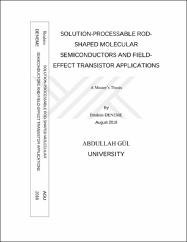| dc.description.abstract | The structural design and synthetic development of novel n-channel organic semiconductors have attracted considerable scientific and technological attention in order to understand the fundamentals of charge-transport mechanisms in organic (opto)electronics. Although large number of n-channel semiconductors have been reported in the literature over the past few decades, solution-processable and air-stable n-channel semiconductors are still scarce. Herein, we report the design, synthesis, single crystal structures, optoelectronic properties, solution-processed thin-film morphologies/microstructures, and organic field effect characteristics of two molecular indeno[1,2-b]fluorenes containing (triisopropylsilyl)ethynyl groups in the 2,8-positions functionalized with carbonyl and dicyanovinylene moieties in the 6,12-positions. Inclusion of electron-withdrawing carbonyl, dicyanovinylene, and (triisopropylsilyl)ethynyl groups to indeno[1,2-b]fluorene cores create fully acceptor type ?-conjugated structures, 2,8-(triisopropylsilyl)ethynyl-indeno[1,2-b]fluorine-6,12- diones (TIPS-IFDK) and 2,8-(triisopropylsilyl)ethynyl-indeno [1,2-b]fluorine-6,12- bis(dicyanoviynlene) (TIPS-IFDM). HOMO/LUMO energies of the new compounds are -5.77/-3.65 eV and -5.84/-4.18 eV for TIPS-IFDK and TIPS-IFDM, respectively. Slightly increased optical band gaps of 2.12 eV (for TIPS-IFDK) and 1.66 eV (for TIPS-IFDM) compared to previously developed donor-acceptor type indenofluorenes could be attributable to their acceptor type ?-conjugated structures. Solid-state ii arrangements and intermolecular ?-? interactions of TIPS-IFDK and TIPS-IFDM were examined via single single-crystal X-ray diffraction (XRD) analysis. The new semiconductors exhibited 1-D columns in the solid-state. OFETs in top-contact/bottomgate transistor geometry utilizing TIPS-IFDM semiconductor layer fabricated via solution-shearing possessed n-channel charge transporting characteristics with an airstable electron mobility 0.02 cm2 (V s)-1 and Ion/Ioff ratios of 107 . However, TIPS-IFDK exhibited three orders of magnitude lower electron mobility in OFETs because of less effective ?-? interactions and the poor crystallinity in thin-film phase, and TIPS-IFDK based OFETs did not exhibit ambient stability. Electronic effects of (trialkylsilyl)ethynyl grops substitutions on frontier molecular orbitals were reavealed by DFT calculations. To the best of our knowledge, TIPS-IFDM is the first example of a solution-processable, air-stable n-type molecular semiconductor functionalized with (trialkylsilyl)ethynyl groups along the long molecular axis. Our results clearly provide a novel molecular design approach for the development of easily synthesizable, solution-processable semiconductors for ambientstable n-channel organic field-effect transistors and potentially various organic (opto)electronic technologies. | en_US |


















